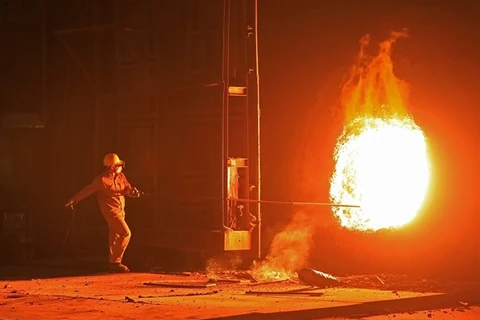Hanoi (VNS/VNA) - After the European Union (EU), the US will be the next to take its climate fight globally with the proposal of the Clean Competition Act, which, if passed, would impose border-adjusted carbon tariffs on its carbon-intensive imports.
Nguyen Vo Truong An, Deputy director of the Carbon Credit Trading Platform JSC (CCTPA), said a majority of Vietnamese firms are not ready for the mechanism because carbon credit trading is new in Vietnam and has not been put on their agenda.
He suggested the formation of a consulting agency, which would be responsible for keeping firms well-informed about the registration and verification of carbon credits. With the agency, they, he believed, would be "better prepared for the new carbon tariff regime".
It is worth noting that CCTPA was the very first carbon trading platform in Vietnam, inaugurated in late September by the CT Group.
Nguyen Linh Ngoc, former Deputy Minister of Natural Resources and Environment, said the market of carbon credit had taken shape in Vietnam since 2005 with the country's accession to the UN-run Clean Development Mechanism (CDM).
Several years later, Vietnam proceeded with its carbon-neutral ambitions by participating in the Gold Standard (GS) and the Verified Carbon Standard (VCS). By late 2022, about 29.4 million carbon credits have been created in the country under CDM and 10 million under GS and VCS.
To promote the market, he called for high-quality technical infrastructures to support its connection with global markets. He said Vietnam must act quickly to kickstart the platform, or else it would miss the advantage of being an early mover.
"The platform is scheduled to go live in 2025, but it'd better be sooner," said Ngoc.
To Xuan Phuc from Humboldt University of Berlin outlined over 170 types of carbon credits available on global markets today, with each coming with a different price.
He also outlined several questions for Vietnam to answer before putting the platform into operation: Who are the sellers and buyers? How do they create credits on the platform? Will the credits be recognised globally?
An said in Vietnam, carbon credits are potentially high in sectors that support the construction of renewable energy plants, including solar and wind farms, which help to offset the carbon emissions from heavy industries.
He also said Vietnamese firms are more likely to be low-balled by foreign buyers when trading carbon credits in voluntary markets because of the nature of their deals. However, this is not the case in regulatory markets.
"Carbon credit prices will not deviate from their true value on the platform because they are determined by supply and demand," said An.
He revealed that the main objectives of CCTPA, for now, include acting as a consultant for individuals and firms on carbon credits. It will also be in charge of verifying and monitoring carbon-offsetting projects and providing solutions to individuals and firms that want to minimise their environmental impact.
CCTPA aims to become the largest platform in the ASEAN region on the horizon.
There are broadly two types of carbon markets, the regulatory market and the voluntary market. The former is government-regulated whereas the latter operates on a voluntary basis.
Market actors can buy carbon credits either directly from developers, through brokers, or on digital trading platforms. According to MarketsandMarkets, total carbon credits traded on digital platforms are projected to reach 317 million USD in 2027 globally, against 106 million USD in 2022./.
Nguyen Vo Truong An, Deputy director of the Carbon Credit Trading Platform JSC (CCTPA), said a majority of Vietnamese firms are not ready for the mechanism because carbon credit trading is new in Vietnam and has not been put on their agenda.
He suggested the formation of a consulting agency, which would be responsible for keeping firms well-informed about the registration and verification of carbon credits. With the agency, they, he believed, would be "better prepared for the new carbon tariff regime".
It is worth noting that CCTPA was the very first carbon trading platform in Vietnam, inaugurated in late September by the CT Group.
Nguyen Linh Ngoc, former Deputy Minister of Natural Resources and Environment, said the market of carbon credit had taken shape in Vietnam since 2005 with the country's accession to the UN-run Clean Development Mechanism (CDM).
Several years later, Vietnam proceeded with its carbon-neutral ambitions by participating in the Gold Standard (GS) and the Verified Carbon Standard (VCS). By late 2022, about 29.4 million carbon credits have been created in the country under CDM and 10 million under GS and VCS.
To promote the market, he called for high-quality technical infrastructures to support its connection with global markets. He said Vietnam must act quickly to kickstart the platform, or else it would miss the advantage of being an early mover.
"The platform is scheduled to go live in 2025, but it'd better be sooner," said Ngoc.
To Xuan Phuc from Humboldt University of Berlin outlined over 170 types of carbon credits available on global markets today, with each coming with a different price.
He also outlined several questions for Vietnam to answer before putting the platform into operation: Who are the sellers and buyers? How do they create credits on the platform? Will the credits be recognised globally?
An said in Vietnam, carbon credits are potentially high in sectors that support the construction of renewable energy plants, including solar and wind farms, which help to offset the carbon emissions from heavy industries.
He also said Vietnamese firms are more likely to be low-balled by foreign buyers when trading carbon credits in voluntary markets because of the nature of their deals. However, this is not the case in regulatory markets.
"Carbon credit prices will not deviate from their true value on the platform because they are determined by supply and demand," said An.
He revealed that the main objectives of CCTPA, for now, include acting as a consultant for individuals and firms on carbon credits. It will also be in charge of verifying and monitoring carbon-offsetting projects and providing solutions to individuals and firms that want to minimise their environmental impact.
CCTPA aims to become the largest platform in the ASEAN region on the horizon.
There are broadly two types of carbon markets, the regulatory market and the voluntary market. The former is government-regulated whereas the latter operates on a voluntary basis.
Market actors can buy carbon credits either directly from developers, through brokers, or on digital trading platforms. According to MarketsandMarkets, total carbon credits traded on digital platforms are projected to reach 317 million USD in 2027 globally, against 106 million USD in 2022./.
VNA























